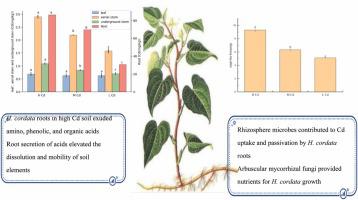当前位置:
X-MOL 学术
›
Ecotox. Environ. Saf.
›
论文详情
Our official English website, www.x-mol.net, welcomes your feedback! (Note: you will need to create a separate account there.)
Cadmium phytoremediation potential of Houttuynia cordata: Insights from growth, uptake, and rhizosphere mechanisms
Ecotoxicology and Environmental Safety ( IF 6.8 ) Pub Date : 2024-05-02 , DOI: 10.1016/j.ecoenv.2024.116417 QingQing Zhang , Cheng’Ai Jiang , LuoYan Jiang , RongLiang Qiu , ZeBin Wei , QiTang Wu
Ecotoxicology and Environmental Safety ( IF 6.8 ) Pub Date : 2024-05-02 , DOI: 10.1016/j.ecoenv.2024.116417 QingQing Zhang , Cheng’Ai Jiang , LuoYan Jiang , RongLiang Qiu , ZeBin Wei , QiTang Wu

|
Cadmium (Cd) pollutes 7.0 % of China’s land area. This study examined the potential of for Cd phytoremediation because of its ability to accumulate Cd in its growth matrix. were planted in plastic pots filled with paddy field soils having low (LCd), medium (MCd), and high (HCd) Cd levels of 0.19, 0.69, and 2.91 mg/kg, respectively. After six months of growth, harvested plant parts were evaluated for Cd uptake and tolerance mechanisms. Metabolomics and metagenomics approaches were employed to investigate the soil rhizosphere mechanism. Results showed that the average plant biomass increased as soil Cd increased. The biomass Cd contents surpassed the allowable Cd limits for food (≤ 0.2 mg/kg) and medicinal uses (≤ 0.3 mg/kg). Cd contents were higher in roots (30.59–86.27 mg/kg) than in other plant parts (0.63–2.90 mg/kg), with significantly increasing values as Cd soil level increased. Phenolic acids, lipids, amino acids and derivatives, organic acids, and alkaloids comprised the majority (69 in MCd vs HCd and 73 % in LCd vs HCd) of the shared upregulated metabolites. In addition, 13 metabolites specific to root exudates were significantly increased. The top two principal metabolic pathways were arginine and proline metabolism, and beta-alanine metabolism. increased the abundance of and across all three Cd levels, and also stimulated the growth of , , and in HCd. Accordingly, demonstrated potential for remediation of Cd-contaminated soils, and safety measures for its production and food use must be highly considered.
更新日期:2024-05-02































 京公网安备 11010802027423号
京公网安备 11010802027423号